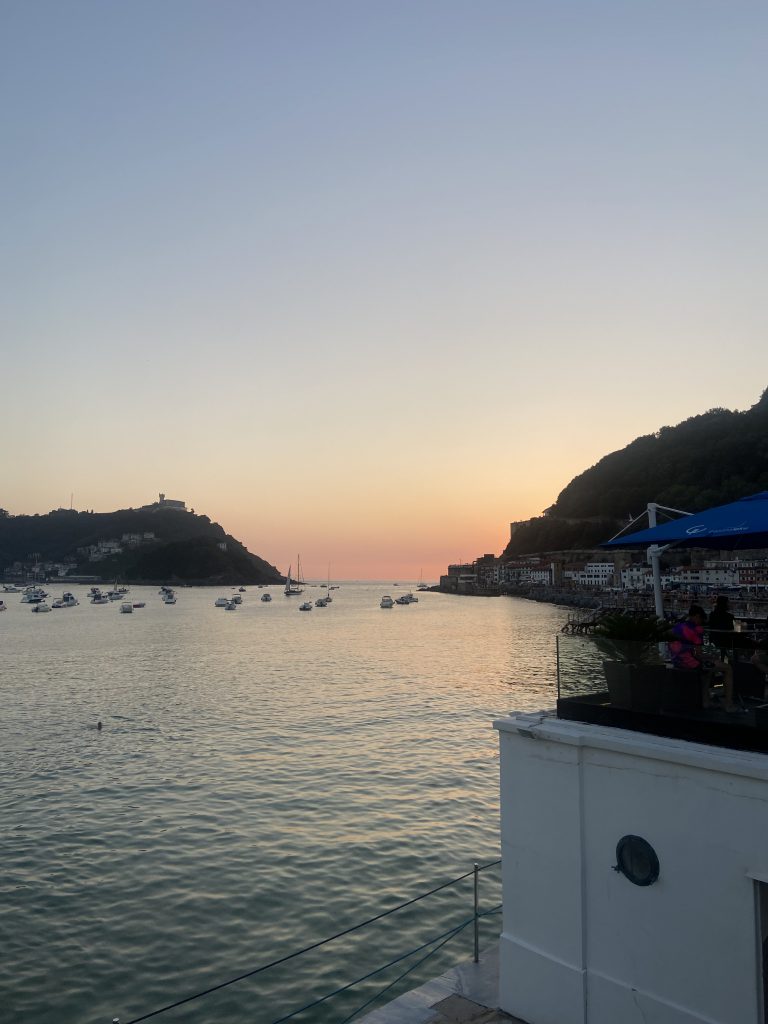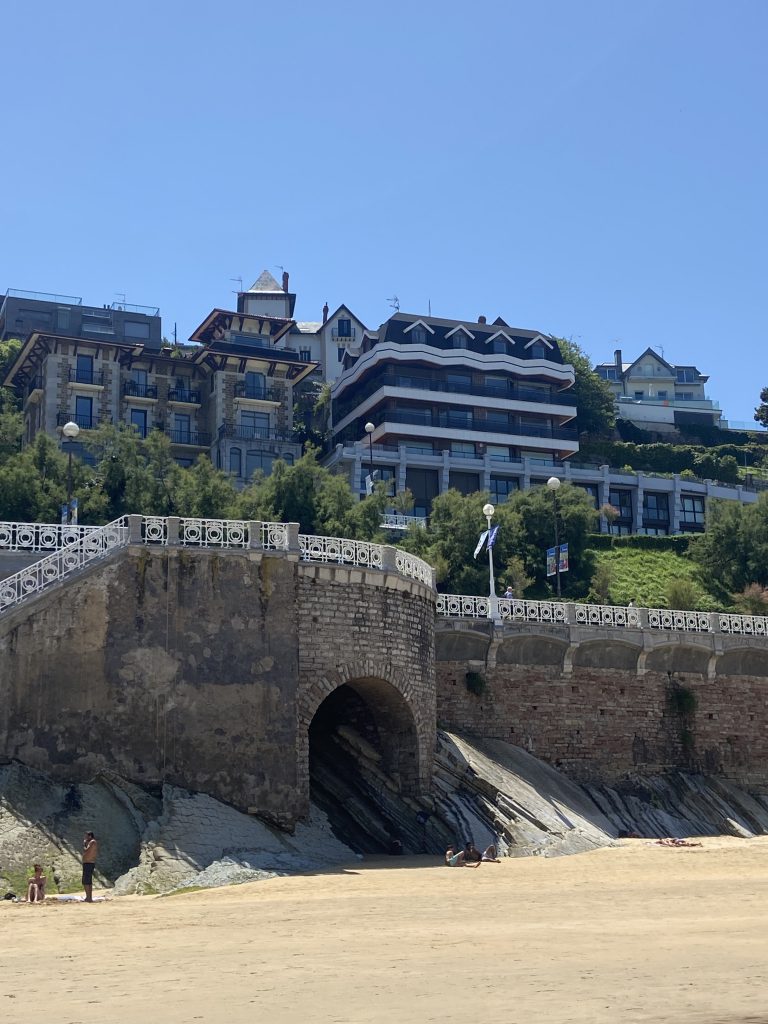At 1 o’clock in the Basque Country, it is typical to see its citizens talking inside and outside restaurants and bars, a glass of wine or a bottle of beer in hand, living by their motto to “drink a little often”. But, more importantly, what goes along with their glasses are their famous pintxos— one of the greatest (if not the greatest) delicacies of the small city of San Sebastián, Spain. Originating in the Basque Country in the 1930s, its meaning lies in the verb pinchar in Spanish, which literally means to spike. This makes sense, as pintxos are often served with toothpicks or skewers “spiked” through them (but not always). That’s as much as I knew of them to begin with, having been introduced to the tradition through Marti Buckley’s Basque Country. But, of course, it is not enough to simply read about them.
The beginning of the afternoon on an unexpectedly bright Wednesday afternoon saw me and my group (along with Professor Julian) getting to know some of the pintxo places in the Old Town of San Sebastian, or what I like to call, pintxo-hopping. The Old Town is the city with the most bars per square meter in the world, apparently. Our adventure began at Antonio’s, right on Boulevard Street. It is a cozy open space inside, with bartenders hidden behind a large counter serving drinks to the people as they choose their preferred pintxos behind the display glass. As for us, we had our own table at the back of the restaurant with many dishes that frankly I never would have ordered if I had been alone. But when studying abroad every foreign flavor counts, no matter how unappealing it may seem at first. There is a certain privilege in being able to get to know another culture so different from my own.

With a glass of Katxiña (a white wine), the first pintxo we had was a tortilla de patata (potato tortilla). Every bite was a soft encounter with sliced potatoes, caramelized onions, and pieces of omelet (something I’m discovering Basques love to put in their dishes). It is a popular dish all over Spain, but it’s especially flavorful in Northern Spain (Professor Julian swears Southern Spain does not make it right). It usually isn’t served with any sauce or extra seasoning that involves spice as Basques don’t have the palette for that. But even for those who enjoy spice, this is a must-try, as the ingredients work splendidly together. This remains one of the favorites of the day.
At this same place is a shrimp ravioli that is among chefs’ favorites when it comes to pintxos. It comes with a white sauce that can be described as a sweeter alfredo sauce, with parsley oil on top. I only had a bite because, at least before the end of the day, I thought myself not to be a fan of shrimp. But I heard from my fellow pintxo tasters that it was not chewy and worked well with the white sauce.

Our next dish at Antonio’s was an ox tail pintxo with mustard and some other flavorful brown sauce. Now, I’m not one for eating less commonly bought parts of animals, but two of us (me included) thought it tasted like cheeseburgers. Unfortunately, it says a lot about us Americans to describe a dish in a foreign country as tasting like a cheeseburger, but I must emphasize that I am aware that this comparison does little justice. However, it is savory and a great choice for one of the first pintxos we tried.
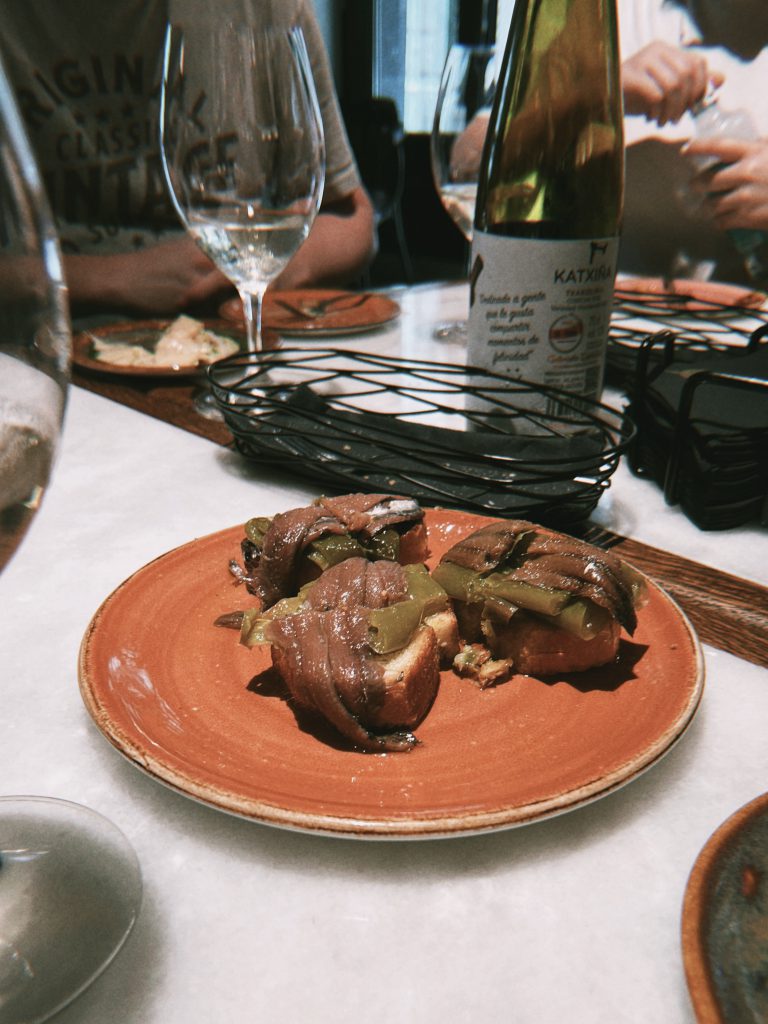
The last pintxo we had there was anchovies served on green pepper and bread. The bread is a staple for almost all pintxos, and they’re made fresh each day because the next day they become rock hard. Anchovies were something I’d seen in Buckley’s book as being very common in Northern Spain, being so close to the shoreline. I was surprised to find that they taste salty and vinegary. We definitely needed water (and wine) to quench our thirst after it.
Part of going out to eat pintxos is socializing with whoever is there with you. We spent a while talking about our trip and about the food. We left there about an hour later to visit Paco Bueno’s for their famous beer-battered shrimp, a hot pintxo. The bar was originally opened by a man named Paco Bueno who was a boxer. His son eventually took over, and then so did his son. A generational pintxo place, no doubt. It is one of the last old-style pintxo places in San Sebastian, and you can tell by its classic wooden-tile flooring and the napkins adorning the floor (a sign that this pintxo place is well-liked by its visitors). Behind the bar is a shelf holding the ’93 rugby ball, boxer gloves, and other sports decorations, suiting the bar’s vintage feel.
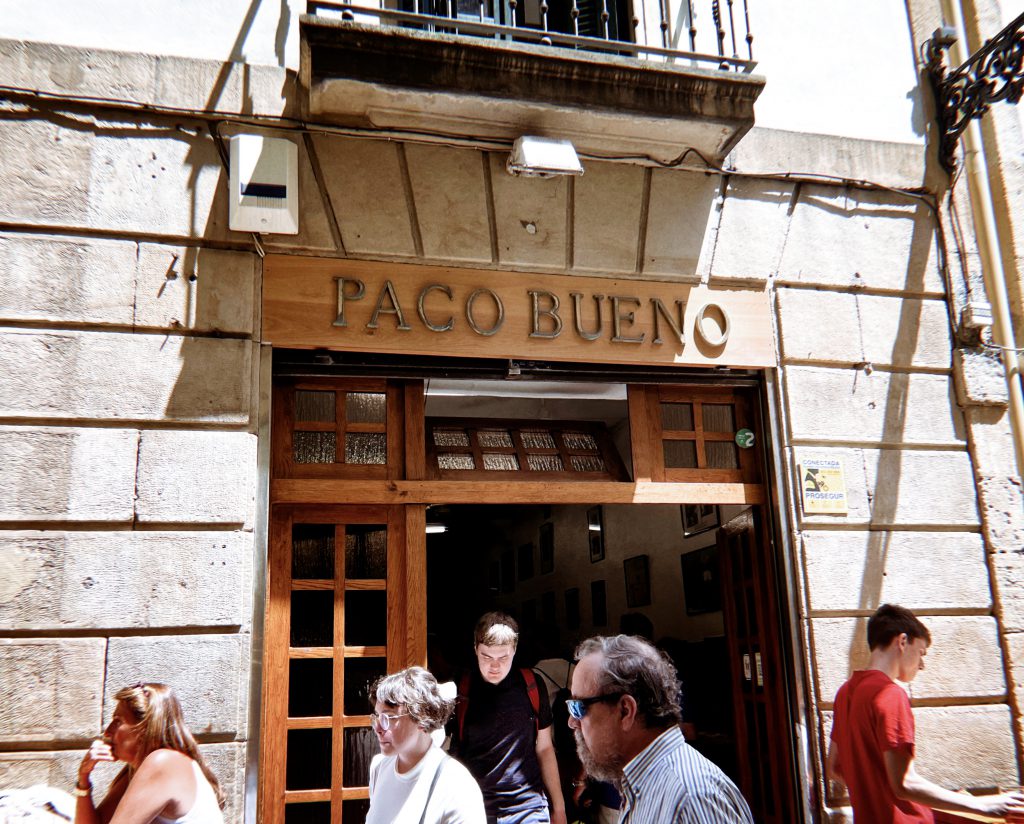
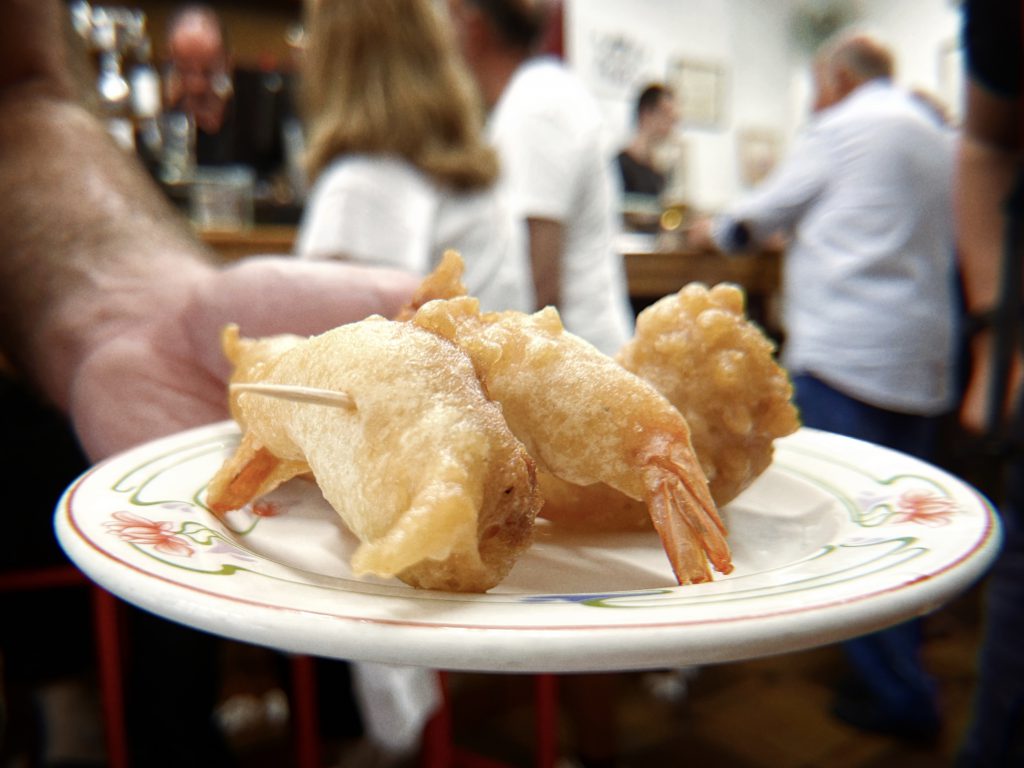
We wait a few minutes before a waiter comes out of a kitchen, a platter of beer-battered shrimp cascading on it. And for the first time, I feel as though I actually like shrimp. This pintxo in its fried glory is not too thick in its batter nor too oily. The shrimp is far from being chewy and its flavor still comes through. It is so well-liked that its secret recipe was not given to Marti Buckley for her pintxo book coming out in the Spring. It is a secret that will remain within the family, most likely, and rightfully so.
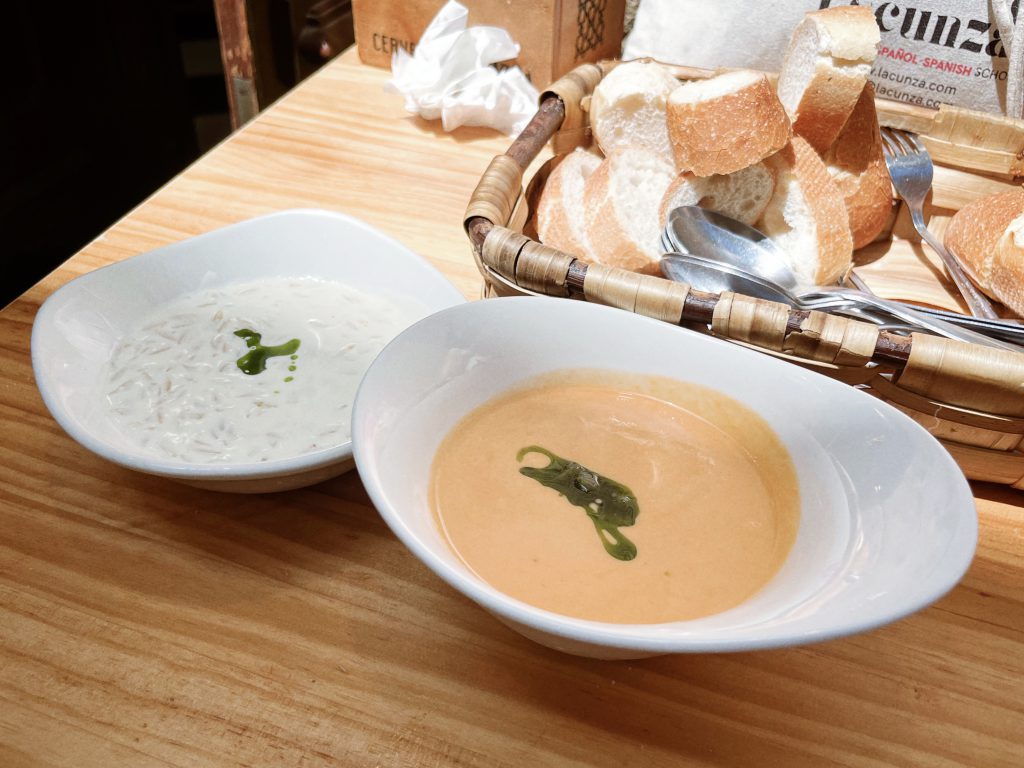
Our last pintxo place was Bordaberri, which only serves hot pintxos as opposed to also having cold pintxos around the bar which can be reheated. It was founded by two Basque chefs and continues to be a popular local go-to. We had several dishes here, including salmorejo (a cold tomato-based soup), and risotto made of idiazábal (an award-winning smoked goat cheese of San Sebastian). These we used as dips for our basket of bread as we ate the other pintxos.

The one that we liked the most was the pork rib kebab, coated in a sweet sauce that leaves you satiated at each bite. The second best was the white tuna with cucumber on top and a lemon-zest sauce. A surprising dish for any seafood lover would be the kokotxas de bacalao (cod neck) with a sauce made of parsley, olive oil, and garlic. The brave ones in my group described it as “almost gelatinous”, a little salty, but with no fishy taste. Unfortunately, it was “not flavorful enough” for Priyanka, one of the girls in my pintxo tasting group.
As one passes through the small people-filled streets of the Old Town, it’s impossible to not notice the history beneath one’s feet. Walking on cobbled streets, passing by Baroque buildings and churches that even have bullet holes from the Spanish War. It is as if one is going back in time.
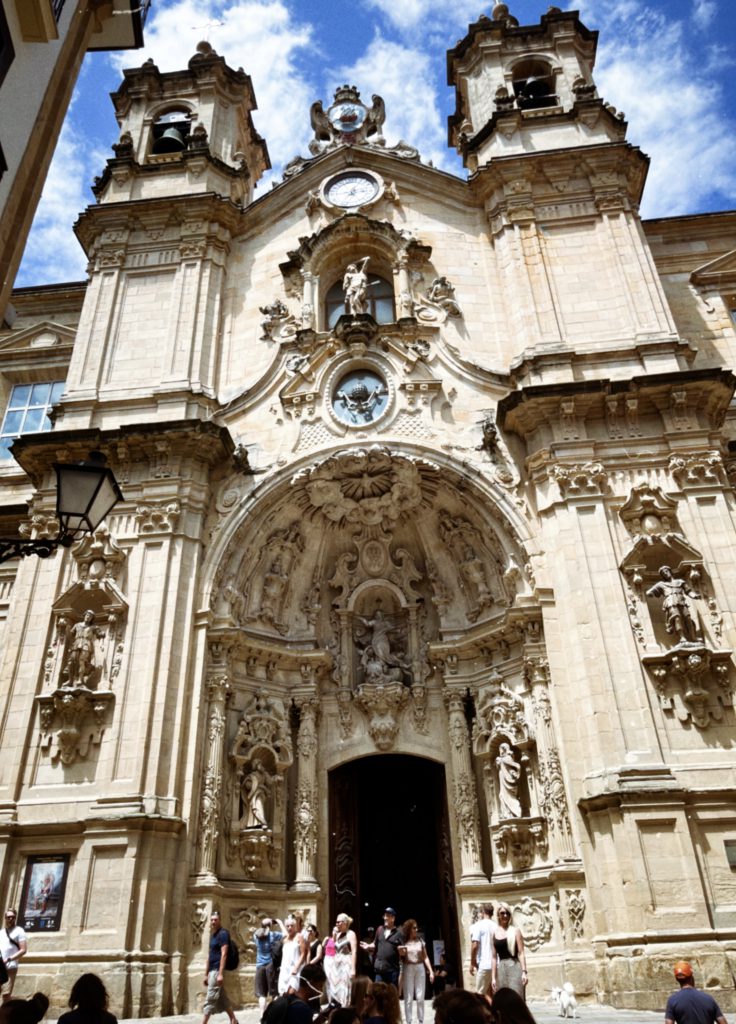
Of course, we couldn’t miss out on dessert after all our pintxos, so we stopped by La Viña for San Sebastian’s twist on cheesecake. It’s softer than what we have in the U.S., and its crust thinner, but a light way to top off our full stomachs.

Many other popular pintxo places around the Old Town were recommended to us by Professor Julian, but we didn’t have time to explore all of them as a group. However, close to the end of the day, right before locals begin closing their own shops and finishing their work to go out and enjoy the city’s wonderful cuisine themselves, a friend and I visited one called Ganbara. It is so well-liked by locals and tourists that there was a line of people waiting outside for a table. We were more than willing to wait around thirty minutes to get seated and discover what it is that everyone seemed to love. And boy, did we find out.


In a way, it’s a restaurant very focused on its seafood pintxos. They all tasted exceptionally fresh and flavorful. The bread itself seemed to have some seasoning on it, and, with some pintxos, it strayed away from the traditional sliced bread and moved more toward a croissant. Both types were soft on the inside, which is a good sign that it’s fresh. We had a cod pintxo that was savory and with no remembrance of it being fish at all. A highlight of the night was the salmon, shrimp, and egg pintxo. Something that anyone will notice is that pintxo places seem to have perfected them and made them into art. It makes one wonder who are the chefs that are behind the magic. We really noticed this with this pintxo, as it even had shaved egg topping it. The shrimp was perfectly cooked and not too strong.
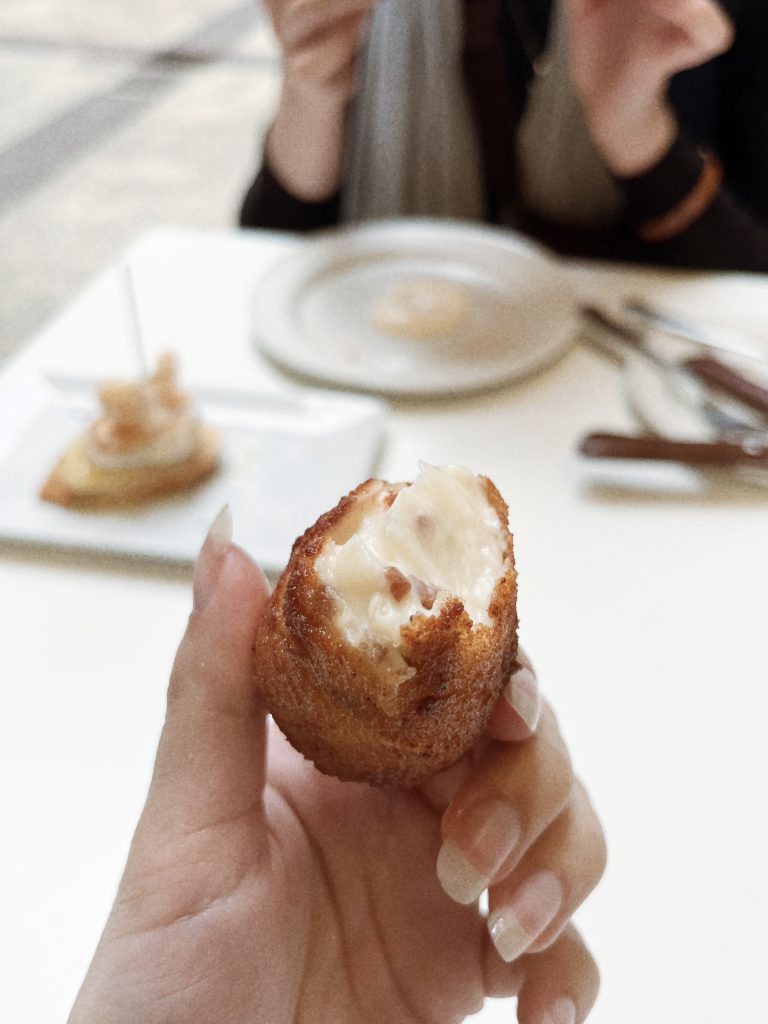
Despite all the seafood, I also had a croqueta de ramón (ham croquette). The first thing that hit me was its almost sweet smell, and it had me wanting to take a bite all too quickly before it cooled down enough. Inside is a creamy texture, with I’m assuming pieces of ham inside. The crunchy outer layer and the creamy inside made for a perfect juxtaposition. Overall, it is definitely a pintxo-place living up to its reputation.
There are so many pintxo places in San Sebastian, and the ones in Old Town are just some of the flavors. While some places are good for a one-time visit to get to know that particular place’s cuisine and style, others are definitely places to return to and experience again.

